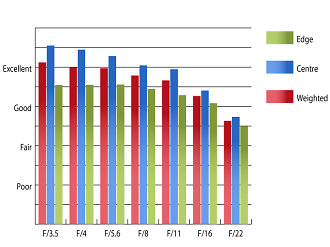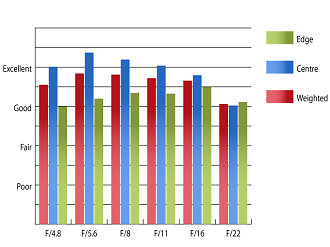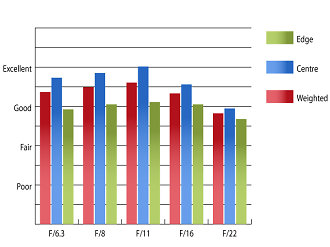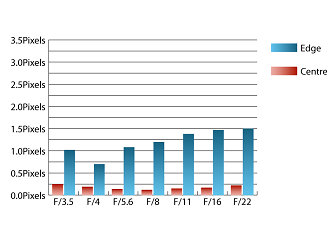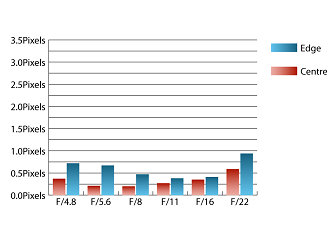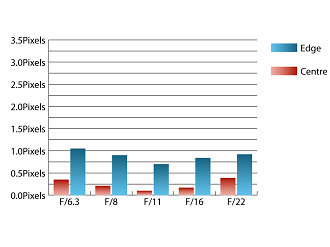Sigma 18-200mm f/3.5-6.4 DC Macro Lens Review
Sigma 18-200mm f/3.5-6.3 DC Macro OS HSM Performance
At 18mm sharpness in the centre of the image area is outstanding in the centre from maximum aperture, dropping gradually due to diffraction as the lens is stopped down. Sharpness towards the edges is very good at this focal length and remains so until the lens is stopped down to f/8
Zooming to 50mm results in a slight reduction of overall sharpness. At maximum aperture the clarity in the centre is still excellent and the quality towards the edges is good. Sharpness towards the edges increases gradually as the lens is stopped down with peak quality being recorded between f/5.6 and f/11 for this focal length.
Finally, at 200mm sharpness in the centre of the frame remains very good, with clarity towards the edges falling just short of good levels. Stopping down to f/11 results in excellent sharpness in the centre and good performance towards the edges of the frame.
How to read our charts
The blue column represents readings from the centre of the picture frame at the various apertures and the green is from the edges. Averaging them out gives the red weighted column.The scale on the left side is an indication of actual image resolution. The taller the column, the better the lens performance. Simple.
For this review, the lens was tested on a Canon EOS 7D using Imatest.
Chromatic aberrations rise and fall as the lens is zoomed through the range and for different aperture values. At 18mm CA levels are quite high towards the edges of the frame when stopped down beyond f/8 and may become apparent in large prints with areas of high contrast near the edges.
How to read our charts
Chromatic aberration is the lens' inability to focus on the sensor or film all colours of visible light at the same point. Severe chromatic aberration gives a noticeable fringing or a halo effect around sharp edges within the picture. It can be cured in software.Apochromatic lenses have special lens elements (aspheric, extra-low dispersion etc) to minimize the problem, hence they usually cost more.
For this review, the lens was tested on a Canon EOS 7D using Imatest.
Falloff of illumination towards the corners is reasonably well controlled. At 18mm the corners are 1.42 stops darker than the image centre and at 200mm the corners are 1.26 stops darker. Visually uniform illumination is achieved with the lens stopped down by just over a stop from maximum aperture throughout the zoom range.
Distortion is often a weakness of high ratio zooms like this. Although the 3.3% barrel distortion at 18mm is quite strong, it isn't all that bad when compared to some similar lenses. Pincushion distortion of 1.34% is present at the telephoto end, which shouldn't pose too many issues for most. If you require completely straight lines, you'll be glad to know that the distortion pattern is uniform across the frame throughout the zoom range, which should make applying corrections in image editing software relatively straightforward.
A petal-shaped hood is supplied as standard with the lens, which does a good job of protecting the front element from extraneous light that may cause unwanted flare and loss of contrast. During testing there were no issues with flare and contrast holds up well, even when shooting into the light.
Value For Money
This 18-200mm Sigma lens includes optical stabilisation and costs around £270. Tamron's 18-200mm XR Di II costs much less at £130, but lacks optical stabilisation, which can be especially useful given the modest f/6.3 maximum aperture both lenses sport at 200mm. It also lacks the silent focusing motor, as found on the Sigma lens.
The Canon 18-200mm f/3.5-5.6 has a brighter maximum aperture at 200mm, supports full time manual focus override and also includes an image stabiliser, but costs around £100 more.
Nikon's 18-200mm f/3.5-5.6 VR II lens is much more expensive at around £560 and sports similar features to the Canon EF-S 18-200mm.
As the Sony compatible version of this Sigma lens doesn't include optical stabilisation, Sony's 18-200mm is almost exactly similar in specification, except for the Sony lens lacking a silent focusing motor. Being priced at around £400, it's around £130 dearer than this Sigma.
Add your message
Please login here or if you've not registered, you can register here. Registering is safe, quick and free.
photodo Stats
428 MTF tests
74 in-depth photodo reviews
100+ users join each day
Help the lens community by reviewing or rating a lens today via our lens search
Latest Lens Reviews
- Chinon 28mm f/2.8 Vintage Lens Review
- Canon EF 70-200mm f/4L IS II USM Lens Review
- Samyang AF 85mm f/1.4 EF Review
- Sigma 70mm f/2.8 DG Macro Art Review
- Samyang AF 24mm f/2.8 FE Review
- Meike 50mm f/1.7 Review
- Tamron 70-210mm f/4 Di VC USD Review
- Lensbaby Burnside 35mm f/2.8 Review
- Asahi Super Takumar 50mm f/1.4 Review
- Asahi Super-Multi-Coated Takumar 135mm f/3.5 Review
